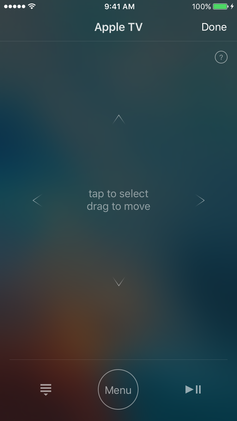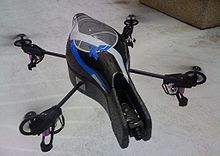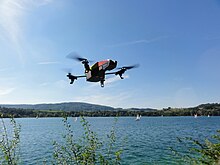
Augmented reality (AR) is an interactive experience that combines the real world and computer-generated content. The content can span multiple sensory modalities, including visual, auditory, haptic, somatosensory and olfactory. AR can be defined as a system that incorporates three basic features: a combination of real and virtual worlds, real-time interaction, and accurate 3D registration of virtual and real objects. The overlaid sensory information can be constructive, or destructive. This experience is seamlessly interwoven with the physical world such that it is perceived as an immersive aspect of the real environment. In this way, augmented reality alters one's ongoing perception of a real-world environment, whereas virtual reality completely replaces the user's real-world environment with a simulated one.

The iPod Touch is a discontinued line of iOS-based mobile devices designed and marketed by Apple Inc. with a touchscreen-controlled user interface. As with other iPod models, the iPod Touch can be used as a portable media player and a handheld gaming device, but can also be used as a digital camera, a web browser, for email and messaging. It is nearly identical in design to the iPhone, and can run most iPhone third-party apps from the App Store, but it connects to the internet only through Wi-Fi and uses no cellular network data since it lacks a cellular modem.

Parrot SA is a French wireless products manufacturer company based in Paris, France. It was founded in 1994 by Christine/M De Tourvel, Jean-Pierre Talvard and Henri Seydoux.

iTunes Remote is a software application developed by Apple Inc. for iOS devices that allows for remote control of Apple TV or iTunes library in an area with Wi-Fi connectivity using the proprietary Digital Audio Control Protocol (DACP). It is currently available as a free download from the App Store for iOS devices such as iPhone, iPod Touch, iPad, and Apple Watch.

A time-of-flight camera, also known as time-of-flight sensor, is a range imaging camera system for measuring distances between the camera and the subject for each point of the image based on time-of-flight, the round trip time of an artificial light signal, as provided by a laser or an LED. Laser-based time-of-flight cameras are part of a broader class of scannerless LIDAR, in which the entire scene is captured with each laser pulse, as opposed to point-by-point with a laser beam such as in scanning LIDAR systems. Time-of-flight camera products for civil applications began to emerge around 2000, as the semiconductor processes allowed the production of components fast enough for such devices. The systems cover ranges of a few centimeters up to several kilometers.
The HTC Evo Shift 4G is a smartphone developed by HTC Corporation and marketed as the concurrent/sequel to Sprint's flagship Android smartphone, running on its 4G WiMAX network. The smartphone launched on January 9, 2011.

AirDrop is a proprietary wireless ad hoc service in Apple Inc.'s iOS and macOS operating systems, introduced in Mac OS X Lion and iOS 7, which can transfer files among supported Macintosh computers and iOS devices by means of close-range wireless communication. This communication takes place over Apple Wireless Direct Link 'Action Frames' and 'Data Frames' using generated link-local IPv6 addresses instead of the Wi-Fi chip's fixed MAC address.

Recon Instruments was a Canadian technology company that produced smartglasses and wearable displays marketed by the company as "heads-up displays" for sports. Recon's products delivered live activity metrics, GPS maps, and notifications directly to the user's eye. Recon's first heads-up display offering was released commercially in October 2010, roughly a year and a half before Google introduced Google Glass.

WEMO, a subsidiary of Belkin, are a series of products from Belkin that enable users to control home electronics remotely. The product suite includes electrical plugs, motion sensors, light switches, cameras, light bulbs, and a mobile app.
ArduPilot is an open source, unmanned vehicle Autopilot Software Suite, capable of controlling autonomous:

ecobee is a Canadian founded home automation company that makes smart thermostats, temperature and occupancy sensors, smart light switches, smart cameras, and contact sensors. They were acquired by the American company Generac Holdings in 2021.

Control Center is a feature of Apple Inc.'s iOS, iPadOS, and macOS operating systems. It was introduced as part of iOS 7, released on September 18, 2013. It gives iOS and iPadOS devices direct access to important settings for the device by swiping down from the top right corner on the iPhone X and newer, and on all iPad models starting with iOS 12 or iPadOS, with previous models using a swipe from the bottom of the screen. It is similar to the SBSettings tweak for iOS jailbreaking. Control Centre was also added to Macs in macOS 11 Big Sur, released on November 12, 2020.

The iPad Air is a tablet designed, developed, and marketed by Apple Inc. It was announced on October 22, 2013, and was released on November 1, 2013. Part of the iPad line of tablet computers, the iPad Air features a thinner design than its predecessors, with similarities to the contemporaneous iPad Mini 2.

The iPad Mini 2 is a tablet computer produced and marketed by Apple Inc. It has a nearly identical design to its predecessor the first-generation iPad Mini, but features internal revisions such as the addition of the A7 system-on-a-chip and 2,048 x 1,536 resolution Retina Display. Internally, the second-generation iPad Mini has nearly the same hardware as its sibling device, the iPad Air. Apple released the second-generation iPad Mini in space gray and silver colors on November 12, 2013.
SkyJack is an unmanned aerial vehicle created by Samy Kamkar which specifically seeks out other Parrot drones and hijacks them through their wireless network, giving the SkyJack pilot the ability to control and view the camera sources of the affected drone.

The Sony ILCE-QX1 is a mobile device mountable, Wi-Fi-controlled, lens-style compact camera manufactured by Sony and was announced on 3 September 2014. Part of the Sony α family, it is one of Sony's "Smart Lens" cameras, alongside the QX10, QX30 and QX100, that are designed to be specifically used with a smartphone. It has a 20.1 megapixel APS-C-size sensor, uses an interchangeable E-mount lens as its highlight feature, supports power zoom but no in-body image stabilization, and has a pop-up flash unlike its other QX siblings.

The DJI Phantom is a series of unmanned aerial vehicles (UAVs), typically quadcopters, developed by Chinese technology company DJI. DJI Phantom devices were released between 2013 and 2019.

The DJI Mavic is a series of teleoperated compact quadcopter drones for personal and commercial aerial photography and videography use, released by the Chinese technology company DJI.

The Sony Cyber-shot DSC-QX100 is a mobile device-mountable lens-style compact camera manufactured by Sony. Announced on September 3, 2014, the QX100 is one of Sony's "Smart Lens" cameras, alongside the QX1, QX10 and QX30, that are specifically designed to be used with a smartphone. Its highlight features are its 1-inch backside-illuminated Exmor R CMOS sensor taken straight from the Sony RX100 II premium compact camera, with 20.2 megapixels, ƒ/1.8 to ƒ/4.9 Carl ZEISS® Vario-Sonnar T* lens and a 3.6x (28–100 mm) optical zoom.

iOS 11 is the eleventh major release of the iOS mobile operating system developed by Apple Inc., being the successor to iOS 10. It was announced at the company's Worldwide Developers Conference on June 5, 2017, and released on September 19, 2017. It was succeeded by iOS 12 on September 17, 2018.






















